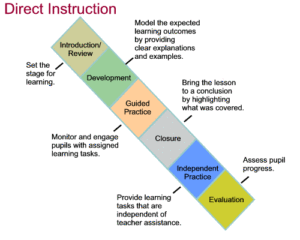What is Direct Instruction?
In direct teaching, teachers use clear teaching techniques to teach students specific skills. This kind of teaching is guided by the teacher, who usually stands at the front of the classroom and provides information. Teachers match their guidance with tasks to enhance students’ understanding of the topic. The technology depends on a rigorous lesson plan and there is little room for change. It does not include active learning activities such as discussions, seminars, or case studies. Direct instruction doesn’t stop at the teacher explaining a concept. There are 6 steps that are very important in the process. Firstly, you set the stage for learning. This is the opening of the lesson, and it’s intended to engage students, get their attention, and activate their prior knowledge. Secondly, using clear and instructive instructions so that students can begin to absorb new materials. Course content should be carefully organized step by step, and each step should complement each other. Thirdly, the teacher and students practice the concept together. The student attempts the skill with the assistance of the teacher and other students. Then, If the student does not understand the course materials, the teacher must correct them and provide feedback. This is also important for guided exercises because students must understand everything at this stage. Fifthly, Independent exercises provide students with the repetitive opportunities needed to combine new information or skills with previous knowledge or skills. Finally, Before continuing to learn new concepts based on what they have just learned, check that your students understand everything.

How is direct instruction connected to visual arts?
In the traditional sense, direct instruction is not suitable for use in visual arts. But I think some basic knowledge and theory of visual art will be better with direct instruction. Because any field or discipline has basic knowledge, direct instruction is a more efficient and time-saving way of teaching when facing basic knowledge learning. Skills first, creativity later. You can practice expression/experiment only if you have the skills, so you must do it first. Any great artist is inseparable from their skilled art skills. Direct instruction enables them to do more creative work because they will subsequently have more expression levels through higher skills. Thay said, direct instruction teaching does actually work to a degree, or you wouldn’t get the outcomes, but it’s superficial because your best students are actually being slowed down by it, and the less able need more time and support.

How is direct instruction connected to our learning resources?
The learning resource of my group is about the process of children participating in collaborative mural homework. They will use paint to create and display their work. Because I am dealing with children aged 6-8, it is necessary to grant them basic artistic knowledge. Let them understand theoretical knowledge, painting skills, and how to evaluate a painting is essential. Direct instruction is a very good way to teach children this boring but essential knowledge. I admit that art cannot use direct instruction too much, because art is about sharing, discussing, and evaluating. Because the audience is children, direct instruction is a more efficient and time-saving way to teach the basics of art. For these reasons, I think it is of great value to incorporate the elements of this learning method into our blueprint.
Resources:
Direct instruction – A practical guide to effective teaching
Direct Instruction art teaching
Direct Instruction
Leave a Reply